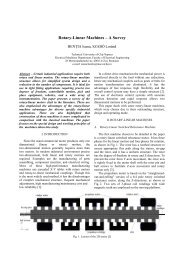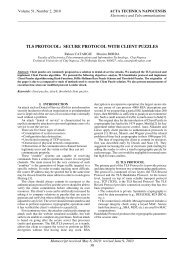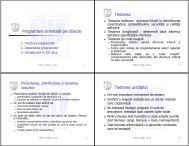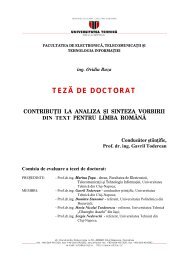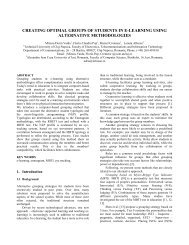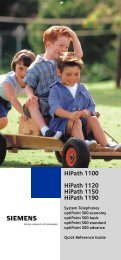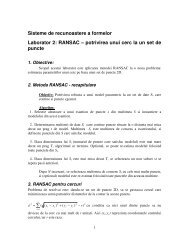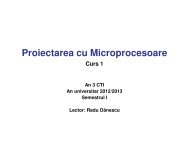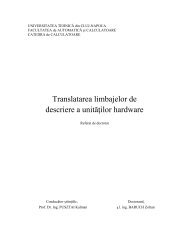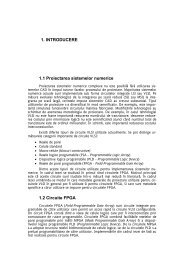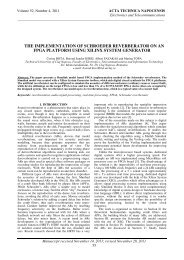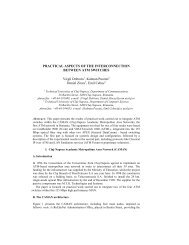LTE Emulator
LTE Emulator
LTE Emulator
You also want an ePaper? Increase the reach of your titles
YUMPU automatically turns print PDFs into web optimized ePapers that Google loves.
TUCN – Data Transmission Laboratory<br />
5. The principle of the simulation process<br />
The design of the simulator has as a main goal the generation of instantaneous bit rate<br />
(delay) and bit error probability statistics which can be reused in several emulation processes,<br />
decreasing in this way the simulation-time and the amount of memory required to store the<br />
mentioned statistics. An important aspect is the removal of the parameters related to the cell<br />
geometry and to the base station transceiver from the simulation process; this approach allows<br />
the use of the same statistics to emulate the transmissions in cells with different characteristics.<br />
To achieve this goal, the simulation process uses as the main parameter the signal to noise ratio,<br />
of the path with the lowest delay of a multipath propagation scenario, SNR0. The simulations are<br />
performed across a range of signal to noise ratios, with an acceptably small separation step, each<br />
simulation generating a set of statistic tables. During the emulation process the SNR0 is<br />
calculated and the appropriate statistics tables are chosen – see first part chapter 3. and paragraph<br />
3.1.1., related to the operating principle of the emulator and to the calculation of the SNR0 value.<br />
The multipath propagation model and the cell load, meaning the number of users and the offered<br />
services, are imposed in the simulation process. Practically, the simulations must be performed<br />
for a limited, but representative, set of multipath propagation models and cell loads; a limited set<br />
means a number of several tens or hundreds scenarios. The dimensions of the statistic tables are<br />
relatively small, tens of kB, allowing the storage of a large number of such statistics on usual<br />
memory circuits.<br />
The simulation process considers two types of users, namely the main user, for which the<br />
tables with instantaneous bit rate and error probability statistics are generated, and a set of<br />
secondary users, which give the load of the cell carrier and which occupy radio resources.<br />
The simulation for a number of transport frames great enough to provide highly reliable<br />
statistics are performed for each value of SNR0 of the main user. The number of the transport<br />
frames has to be at least of several thousands; a larger number of transport frames ensure more<br />
reliable statistics, but also increases substantially the simulation time.<br />
This approach is equivalent to the movement of the main user on a circle with the center<br />
located in the base station and the radius imposed by the value of SNR0 and the used propagation<br />
model, model which depends on the cell type. The total signal to noise ratio used in the<br />
simulation process is computed based on the SNR0 value, on the multipath propagation profile,<br />
on the distribution of the fast fading due to the mobile motion, taking also into account the<br />
channel coherence time.<br />
The motions of the secondary users are simulated by the modification of an attenuation<br />
parameter associated to each secondary user; this parameter indicates the distance to the base<br />
station transceiver. It changes for each secondary user in the cadence of the channel coherence<br />
time specific to that user, i.e. a function of the user’s speed. This approach simulates a real case,<br />
where the main user moves on a circular trajectory around the base station and the other users<br />
move randomly inside the cell. In the emulation process the main user motion trajectory is<br />
changed, by moving him from one circle to another. The basic idea of the simulation process is<br />
presented in fig. 5.1.<br />
The attenuation parameter of the secondary users have to be located in a large domain (-30,<br />
+ 30dB), to allow a realistic simulation of the motion between the center and the edge of the cell.<br />
This domain must include both positive and negative values, to allow the simulation of the<br />
relative positions of the secondary users relative to the main user (a positive attenuation means<br />
that the secondary user is located farther to the center of the cell than the main user, while a<br />
negative attenuation means that the secondary user is located closer to the center of the cell than<br />
the main user). The calculation method of the total signal to noise ratio is presented in paragraph<br />
5.1. This signal to noise ratio includes the effect of the multipath propagation and of the motion<br />
generated fast fading and is used for radio resource allocation, both for the main user and the<br />
secondary users.<br />
20



